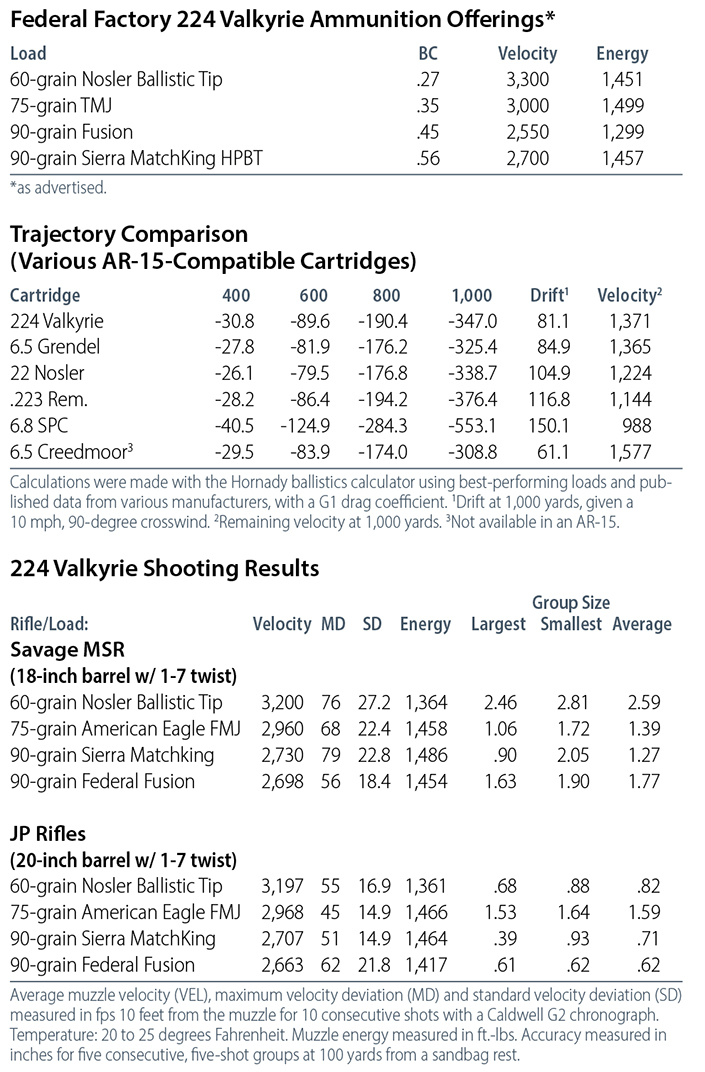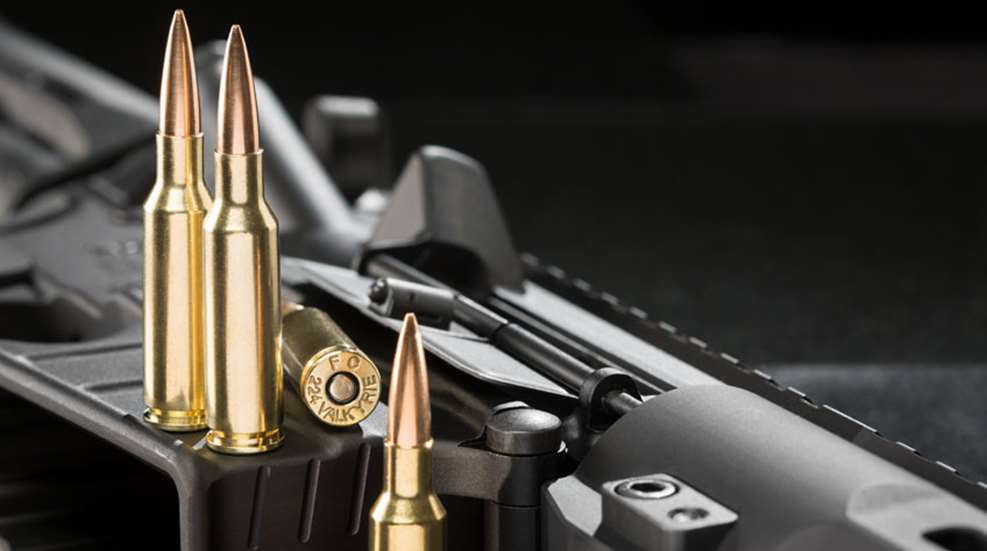
Cartridges are often unfairly compared because shooters tend to look at things from a generalized perspective. If your needs are generalized, this makes sense. However, if you’re looking for specialization, it’s in that venue the comparison should take place. Shooters are also guilty of neophobia, which is an extreme or irrational fear or dislike of anything new, novel or unfamiliar. They’re often afraid a new cartridge will do something better than their favorite, or the one they’re tooled up to support.The 224 Valkyrie is a perfect example.
This novel design from Federal Premium is a fast-stepping .224-caliber cartridge designed for the AR-15, capable of pushing a 75-grain bullet to 3,000 fps. Those who live in the generalized world will be quick to point out the 22 Nosler already does this. That’s very true, but the 22 Nosler is a generalized cartridge. The 224 Valkyrie was engineered to do a specific thing better than any commercially available AR-15 cartridge, and that thing is not general in nature.
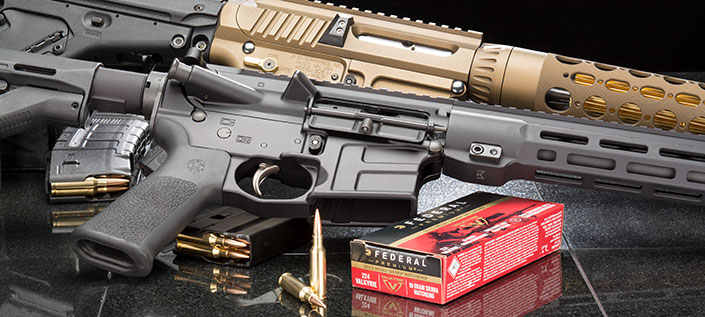
Genealogy of the 224 Valkyrie
Most new centerfire cartridges are based on current cases. There are several reasons for this. For starters, it’s much less expensive to modify an existing case than it is to design a new one. Second, rifles are built to work with what might be considered standard rim diameters. If a cartridge with a new rim diameter is created, new rifles will have to be built to work with it. Similarly, and particularly with magazine-fed weapons, is the problem of magazine compatibility. If a cartridge is created with drastically different dimensions, it will not work with currently available magazines.
Finally, there’s the bullet. Sales for a cartridge created in a caliber for which there are not many suitable bullets would be anemic. To an extent, this was one problem with the 6.8 SPC. Yes, there are lots of .277-caliber bullets to choose from, but those that will work within the magazine and case restrictions of the 6.8 SPC in the AR-15 platform are few.
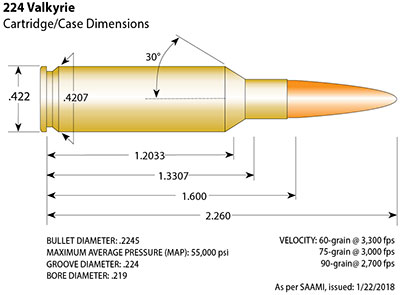
You might say the 224 Valkyrie began life as a .30 Rem., because the 112-year-old .30 Rem. is the case upon which the 6.8 SPC was based. What does that have to do with the 224 Valkyrie? Well, just after the turn of the 21st century, an enterprising wildcatter from Illinois by the name of Roy Winnett created the 22 PDK (Prairie Dog Killer.) The 22 PDK was based on the 6.8 SPC case. As I wrote when I edited the 13th edition of “Cartridges of the World” in 2012: “While the cartridge [22 PDK] does not offer a substantial advantage over the .22-250 Rem. in a bolt-action rifle, it is indeed a lighting rod in an AR-15.”
The 22 PDK never caught on, but the 22 Nosler is essentially its twin, with one exception; the 22 Nosler has a rebated rim. Instead of the .422 rim diameter of the .30 Rem. and 6.8 SPC, the 22 Nosler has a rim diameter of .378. This was important because that’s the same rim diameter of the .223 Rem. It means an AR-15 in .223 Rem. can be converted to 22 Nosler by changing the barrel and switching to 6.8 SPC magazines.

The 224 Valkyrie is based on the 6.8 SPC case and retains the same rim diameter. However, to make the cartridge compatible with long and slender bullets, with ridiculously high ballistic coefficients (BCs), and with standard 6.8 SPC magazines, Federal shortened the 6.8 SPC case, set the shoulder back with a 30-degree taper, and necked it down to accept .224-caliber bullets. Now, while this might not sound like much, it was just enough to allow extremely high-BC bullets to be loaded, without seating them past the ogive. This also kept overall cartridge length short enough to work in standard 6.8 SPC magazines.
This new cartridge, which is really just a modification of a cartridge that’s more than a century old, was submitted to the Sporting Arms and Ammunition Manufacturers Institute (SAAMI). It approved the cartridge on Jan. 22, 2018, with a maximum average pressure (MAP) of 55,000 psi, which is the same as the .223 Rem. This approval is critical because it standardizes the manufacture of guns and ammo, opening up for the production of both by any manufacturer.

Now that you understand the genealogy of the 224 Valkyrie, what might surprise you is where its inspiration came from. While I’m sure no one at Federal will admit it, what the company really did was apply the Creedmoor concept to the 22 PDK/22 Nosler. By shortening the case and changing the shoulder, like Hornady did when transforming the .308 Win./30 TC to the 6.5 Creedmoor, it created a cartridge compatible with very high BC bullets, that will outperform its parents.
224 Valkyrie Range Testing
Modern shooters are like most people: They’re more interested in what something can do for them than its history. Unless you’re a cartridge geek like me, you probably don’t really care where the 224 Valkyrie came from; you just want to know what it’s capable of. To find out, I tested two rifles chambered for it. One was a Savage Arms Recon LRP with an 18-inch barrel and the other an AR from JP Rifles with a 20-inch barrel.
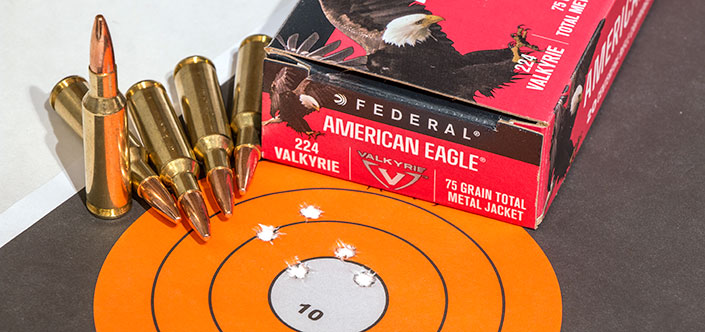
All four 224 Valkyrie factory loads were tested in each rifle, and surprisingly, there was not a lot of variation in velocities even though there was a 2-inch difference in barrel length. With the 60-grain load the difference was only 3 fps, with the 75-grain it was 8 fps. Both 90-grain loads showed a bit more variance, but I consider this of no consequence since maximum muzzle velocity deviations with each rifle were larger than the difference due to barrel length. Whether this would apply to other barrels of a different manufacture is unknown.
More important was if the actual velocities equaled those advertised by Federal for the 224 Valkyrie cartridge. After all, we know it’s not uncommon for published velocities to be, well, optimistic. With both 90-grain loads, actual velocities were slightly higher than the published 2,550 fps for the Fusion load, and 2,700 fps for the Match load. With the 75-grain American Eagle load, actual velocities ran about 30 fps slower. And with the 60-grain Ballistic Tip load, real-world velocities fell about 100 fps short. Overall that’s probably better-than-average performance, when it comes to ammunition living up to advertising hype.
Accuracy was average to excellent. The Savage Recon LRP averaged 1.75 inches for five, five-shot groups with all four factory loads. Based on years of testing various ARs, I’ve found their average precision to be about 1.5 MOA, when multiple random loads are evaluated. That would make the Savage a sub-average performer. However, the Recon just did not like the 60-grain Ballistic Tip load. Take it out of the equation and the average becomes more respectable. On the other hand, the JP rifle was a tack driver. (See page 74.) I guess you get what you pay for; it has a suggested retail of $3,789.95. By comparison, the Savage retails for $1,249. Incidentally, if you combine the overall performance of both rifles, you get an average precision of 1.40 MOA, thus confirming my 1.5-MOA average postulation.
The only reliability issues experienced during the firing of hundreds of rounds of 224 Valkyrie ammunition were with the Savage Recon LRP. While accuracy testing the 90-grain Match load, there were five failures to feed and one blown primer. The case heads were also showing excessive swipe by the ejector. A simple twist of the adjustable gas block corrected both problems. The JP rifle handled all four loads equally well with the same gas block setting.
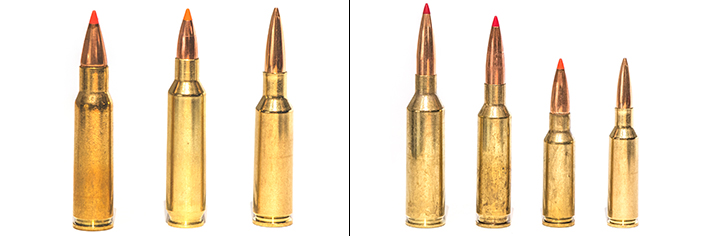
Comparison
You are probably wondering where the 224 Valkyrie is positioned when all the commercially available cartridges compatible with the AR-15 platform are considered. It’s not as fast as the 22 Nosler, mostly because the 22 Nosler has a higher case capacity. However, since the Valkyrie can handle heavier bullets with a higher BC, at extended distance—like at 1,000 yards—the Valkyrie is the better performer. This is mostly because with those high-BC bullets, it retains velocity better and drifts less in the wind.
Inside 500 yards, the Valkyrie performs neck and neck with the .223 Rem. But, because of those slender bullets it can work with, it drops and drifts much less beyond that distance. As for the Valkyrie’s parent cartridge—the 6.8 SPC—it’s simply not in the same class. For long-range shooting, the only commercially available AR-15 cartridge that can compare is the 6.5 Grendel. But, like with the .223 Rem. and 22 Nosler, the Grendel cannot use the highest BC bullets of its caliber. It shoots incredibly flat, but will turn subsonic sooner than the Valkyrie and the wind will push it farther off course.
Specialization
For just about any general-purpose endeavor, especially those of a tactical nature, the .223 Rem. remains the best option in the AR-15. There are simply too many versatile and purpose-built munitions to choose from. Additionally, right now, even the least-expensive Valkyrie ammunition will cost you about 50 cents per trigger pull. You can pick up .223 Rem. ammo for half that.
But, the Valkyrie was not intended as a replacement for the .223 Rem. Right now, shooting at extreme distance is a rising trend, and that is what the Valkyrie was designed to do well. If you want to shoot an AR-15 at stuff beyond 500 yards, and consistently get hits, the 224 Valkyrie is the best option available. The Valkyrie is a specialized cartridge and its only real competition is the 6.5 Grendel, which generates 72 percent more recoil, goes subsonic sooner, drifts more in the wind, and is even more expensive to shoot.
When it comes to hitting at distance, the 6.5 Creedmoor has become the cartridge of choice in bolt-action rifles. In fact, because it’s so effective at distance, and because the MSR platform has become so popular, we’re starting to see AR-10s chambered for the 6.5 and even the 6 mm Creedmoor. The 224 Valkyrie should appeal to that same crowd, specifically those who prefer an AR-15 to an AR-10. Though still shy of the Creedmoor ballistically, from an AR-15 its as close as you’re going to get—at least until something new and even more specialized comes along.
